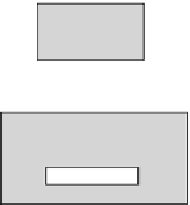Biomedical Engineering Reference
In-Depth Information
Zone 1
Zone 2
Zone 3
Samples
to be
coated
Reactor
geometry
Capacitor plate
Capacitor plate
Flow rate
Pressure
Energy density
Gas
Outlet
Gas
inlet
Temperature
Pressure
regulation
valve
Matching
network
Contamination and
backstreaming
trap
Gas
mixing
and flow
control
Gas
1
Gas
2
Gas
3
Pressure
gauge
RF generator
Vacuum
pump
Power
continuous or pulsed
Fig. 3.2.14-2 A diagram of a capacitively coupled RF plasma reactor. Important experimental variables are indicated in bold typeface.
Zone 1 shows gas storage and mixing. Zone 2 shows components that power the reactor. Zone 3 highlights components of the vacuum
system.
a hydrophobic monomer in the grafting mixture (Ratner
and Hoffman, 1980; Ratner
et al.,
1979).
Photoinitiated grafting (usually with visible or UV
light) represents a unique subcategory of surface modi-
fications in which there is growing interest. There are
many approaches to effect this photoinitiated covalent
coupling. For example, a phenyl azide group can be
converted to a highly reactive nitrene upon UV exposure.
This nitrene will quickly react with many organic groups.
If a synthetic polymer is prepared with phenyl azide side
groups and this polymer is exposed simultaneously to UV
light and a substrate polymer or polymeric medical
device, the polymer containing the phenyl azide side
groups will be immobilized to the substrate (Matsuda
and Inoue, 1990). Another method involves the coupling
of a benzophenone molecule to a hydrophilic polymer
(Dunkirk
et al.
, 1991). In the presence of UV irradiation,
the benzophenone is excited to a reactive triplet state
that can abstract a hydrogen leading to radical cross-
linking.
Radiation, electron beam, and photografting have
frequently been used to bond hydrogels to the surfaces of
hydrophobic polymers (Matsuda and Inoue, 1990;
Dunkirk
et al.
, 1991). Electron beam grafting of
N
-isopropyl acrylamide to polystyrene has been used to
create a new class of temperature-dependent surfaces for
cell growth (Kwon
et al.
, 2000) (also see Section 3.2.6).
The protein interactions (Horbett and Hoffman, 1975),
cell interactions (Ratner
et al.
, 1975; Matsuda and Inoue,
1990), blood compatibility (Chapiro, 1983; Hoffman
et al.
, 1983), and tissue reactions (Greer
et al.
, 1979) of
hydrogel graft surfaces have been investigated.
RFGD plasma deposition and other
plasma gas processes
RFGD plasmas, as used for surface modification, are low-
pressure ionized gas environments typically at ambient
(or slightly above ambient) temperature. They are also
referred to as glow discharge or gas discharge depositions
or treatments. Plasmas can be used to modify existing
surfaces by ablation or etching reactions or, in a de-
position mode, to overcoat surfaces (
Fig. 3.2.14-1
).
Good review articles on plasma deposition and its ap-
plication to biomaterials are available (Yasuda and
Gazicki, 1982; Hoffman, 1988; Ratner
et al.
, 1990; Chu
et al.,
2002; Kitching
et al.
, 2003). Some biomedical
applications of plasma-modified biomaterials are listed in
Table 3.2.14-3
.


















































































